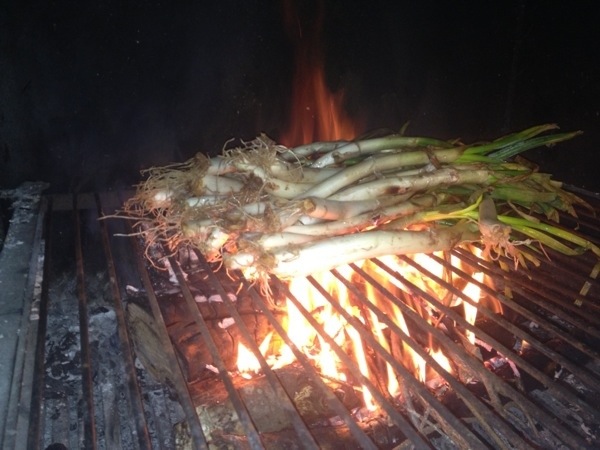Many years ago I arrived in l’Escala with my parents in February for a flying visit to attend some business or other and on the evening of arrival dined at Mesón del Conde in Sant Martí d’Empuries.
While I had visited the restaurant several times before, what immediately caught my attention were the several the tables where the diners wore bibs; as if that wasn’t enough, the waiters carried to the tables what appeared to be terracotta roof tiles full of steaming piles of what looked like leeks.

The diners were picking up the vegetables one by one, dipping them in a sauce and, tipping the head back, dropping it into the mouth; definitely my kind of food.
Intrigued, when we returned to the restaurant at lunchtime on the Sunday I knew what I was ordering. Dressed in my bib, the roof tile – for that is indeed what they are – arrived with its steaming content that I later learned were specially grown spring onions that are chargrilled.
To eat you strip off the charred outer layers, dip the sweet white flesh of the onion into a sauce similar made from almonds, hazelnuts, tomato, garlic, olive oil and tomato, and chilli, which is similar to romesco but, according to calçot aficionados, a different sauce entirely.
I loved them. And not only was I hooked but it also marked the point when my entire family was to fall in love with the calçot and something we all looked forward to whenever we were in l’Escala during the winter; and when I moved to Barcelona from the UK I was lucky enough to have a restaurant specialising in calçots just around the corner.
During the winter months calçots are served as part of the “calçotada”, a feast comprising of calçots as a starter followed by a selection of grilled meats and accompanied by pa amb tomàquet and wine. The onions originate from Valls, near Tarragona, and every year during the last weekend of January the town is taken over by the smell of calçots as visitors flock from around Catalonia to see how they are grown, watch demonstrations of sauce making, and then queuing to eat the delicacy, which are cooked on wood fires in the town’s squares.
The town also has a calçot eating competition, in which the participants are each given a pile of the onions. The winner is whoever can eat the most in a hour; I know someone who took part and managed over 100, but the champion can eat many more; the 2012 winner consumed 288 calçots!
While the calçotada originates from the south of Catalonia you do see them advertised in many restaurants on the Costa Brava these days, although nowhere nearly as much as in the south of Catalonia. I was lucky to see them in Meson del Conde all those years ago, which I reckon must have been about 1988 or ’89 and would have been just a couple of years after Valls started to really promote calçots and the calçotada.
These days I’ve got a restaurant specialising in calçots about half a kilometre from home, which we’ve been to a couple of times. However, since calçots are widely available in supermarkets now it is easy to cook them on the open fire at home; we’re not the only ones either, as you can often smell the distinctive aroma of calçots while strolling the neighbourhood on a Sunday lunchtime.
While the sauce has always been the most time consuming operation in the calçotada, a readymade calçot sauce is available from supermarkets year round. It’s not as good as a homemade sauce, but grinding down dozens of almonds isn’t my idea of fun.
How to cook calçots
I’ve been cooking calçots for years now, first while in the UK where I’d use large spring onions, and if there is one secret to cooking them it is this; the fire needs to be really hot.
Forget cooking on the embers, you need to cook them while the fire is going strong. To do this you need to cook with wood. I’ve tried many times on a barbeque with charcoal, but it takes forever to do them.
In Valls they have hundreds of calçots cooking at once; the huge piles of onions are cooked over an inferno, and you need to aim to do the same.
Once the flames are really going you can put the calçots on the grill and they’ll take ten minutes or so to cook through. They should be quite charred, but once the outer layers are stripped off the white flesh should be soft. The first ones will be steaming hot, so you may need to let them cool a bit before eating.
Pick one from the top and holding the bulb in the other hand strip off the black layers. Spoon a generous amount of sauce onto your plate and tip the bulb into the sauce to coat; raise to you mouth and take a mouthful and be thankful that winter is here!
Interested in learning more about Catalan cookery?

Available from Amazon.com and Amazon.co.uk

